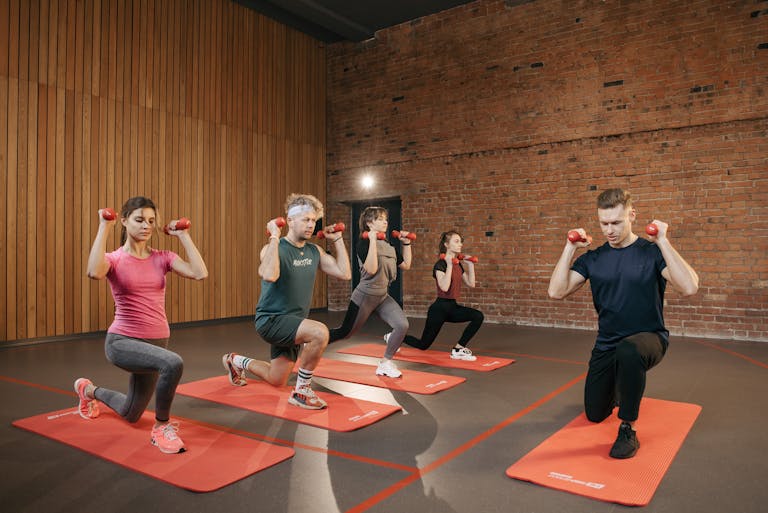Are you getting the most out of your workouts, or are you just going through the motions? Many fitness enthusiasts spend hours exercising without fully understanding how to maximize the benefits of their efforts. The secret is heart rate zones—a scientifically proven method that can turn your fitness routine from guesswork into precision training.
Heart rate zone training isn’t just for elite athletes; it’s for everyone. It’s a powerful tool to help you tailor your workouts to your fitness level, prevent overtraining and achieve specific goals more efficiently. Whether you want to burn fat, build endurance or increase speed, understanding your heart rate zones can change your approach to fitness.
This guide will walk you through everything you need to know about heart rate zones. You’ll learn what they are, how to calculate your zones and specific strategies to use them to achieve your fitness goals. By the end, you’ll have the knowledge and tools to optimize every workout and track your progress like a pro.
Heart Rate Training
Heart rate training is a new, personalized approach to exercising that helps you maximise the benefits of every workout. By paying attention to how many times your heart beats during exercise, you can fine-tune your workout to match your unique fitness goals—whether you want to lose weight, improve cardiovascular health or feel better day to day.
Instead of guessing how hard you should be working, heart rate training provides real-time feedback, allowing you to adjust your exercise program for optimal results and overall well-being. This method enables you to exercise at the optimal intensity, making your workouts more effective and keeping you motivated on your journey to improved health.
What Are Heart Rate Zones?
Heart rate zones are distinct levels of exercise intensity, defined by your heart rate. These zones correspond to the intensity of your cardiovascular system’s work and the energy systems your body is using during exercise.
Your heart rate is the measure of the intensity of your workout. The rate is the number of times your heart beats per minute, a quantitative measure of your heart’s activity. As you exercise harder, your heart beats faster to pump more oxygen-rich blood to your working muscles. This relationship between heart rate and exercise intensity is the foundation of zone-based training.
The body uses two main energy systems during exercise: aerobic and anaerobic. At lower intensities, the body utilizes aerobic metabolism, which utilises oxygen to burn fat and carbohydrates efficiently. As intensity increases, the body shifts to anaerobic metabolism, which provides quick energy but can only be sustained for short periods.
Here’s how the five main heart rate zones break down: Each zone represents a specific heart rate range corresponding to different exercise intensities.
Zone 1 (Active Recovery): 50-60% of maximum heart rate
This is your active recovery zone. Exercise feels very easy, and you can have a full conversation. Your body is burning fat for fuel. Training within your target range means you are working at the right intensity for your goals.
Zone 2 (Aerobic Base): 60-70% of maximum heart rate
This is often referred to as the “fat-burning zone”. Its intensity feels comfortable and sustainable. You can talk in complete sentences. This zone helps build aerobic fitness and improve fat metabolism. Training within your target range means you are working at the right intensity for your goals.
Zone 3 (Aerobic Threshold): 70-80% of maximum heart rate
This is moderate intensity, feels comfortably hard. You can speak in short phrases but not full sentences. Zone 3 improves cardiovascular efficiency and endurance. Training within your target range means you are working at the right intensity for your goals.
Zone 4 (Lactate Threshold): 80-90% of maximum heart rate
This is high intensity, and it feels challenging. You can only speak a few words at a time. Training in Zone 4 improves your ability to sustain higher intensities. Training within your target range means you are working at the right intensity for your goals.
Zone 5 (Neuromuscular Power): 90-100% of maximum heart rate
This is maximum effort territory. You can barely speak, and you can only maintain this intensity for short bursts. Zone 5 training is for speed and power. Training within your target range means you are working at the right intensity for your goals.
Training within the right heart rate range strengthens the heart muscle and enhances its efficiency, resulting in improved overall cardiovascular health.
Heart Rate Basics
Your heart rate, also known as pulse, is the number of times your heart beats per minute and is a key indicator of how your body responds to exercise. For most healthy adults, a normal resting heart rate ranges from 60 to 100 beats per minute; however, this number can vary depending on age, fitness level and other factors such as medical conditions or medications.
The maximum heart rate is the highest number of beats your heart can safely reach during intense exercise, and knowing this number is crucial for setting your target heart rate zone—the ideal range for achieving your fitness goals. Blood pressure and overall cardiovascular health can also influence heart rate, so it’s important to consider these factors when designing your exercise program. By understanding your resting heart rate, maximum heart rate and the factors that influence them, you can create a safer and more effective workout plan tailored to your needs.
The Five Heart Rate Zones
The five heart rate zones are a practical way to measure and manage exercise intensity, helping you maximize the benefits of every workout. Each zone is defined by a percentage of your maximum heart rate and is linked to specific benefits and types of activity.
Zone 1 is the easiest, perfect for warm-ups, cool-downs and gentle aerobic activity like stretching or slow walking.
Zone 2 is a bit more challenging and is ideal for brisk walking, steady jogging, or cycling—perfect for building endurance and supporting long-term fitness goals.
As you progress into Zones 3, 4, and 5, the intensity increases, targeting improvements in aerobic capacity, speed, and power.
By understanding and utilizing all five heart rate zones, you can structure your workout routine to incorporate a range of exercise intensities, ensuring balanced progress and helping you achieve your fitness goals more efficiently.
How to Calculate Your Maximum Heart Rate
The most common method for calculating maximum heart rate is to subtract your age from 220. This simple calculation provides a reasonable estimate for most individuals and serves as the basis for determining your heart rate zones.
For example, if you’re 35 years old, your estimated maximum heart rate would be 185 beats per minute (220 – 35 = 185). While this formula isn’t perfect for everyone, it’s widely used because it’s quick and easy. Another method is the heart rate reserve (HRR) method.
To use this method, first determine your resting heart rate (usually measured first thing in the morning). Subtract your resting heart rate from your maximum heart rate to get your heart rate reserve. Then multiply the HRR by your desired intensity percentage and add your resting heart rate back to find your target heart rates for different exercise intensities. The HRR method is beneficial because it takes into account your fitness level and provides more personalized target heart rate zones.
More accurate methods include laboratory testing or field tests conducted under the supervision of fitness professionals. Some advanced fitness trackers and smartwatches can also estimate your maximum heart rate based on your workout data and heart rate variability.
Some individuals may have a lower maximum heart rate due to medications, health conditions or individual fitness levels. This should be considered when calculating your zones, as adjustments may be necessary.
Here’s a step-by-step guide to calculate your heart rate zones:
Step 1: Calculate your maximum heart rate
Use the formula: 220 – your age = maximum heart rate
Step 2: Determine each zone
- Zone 1: Maximum HR × 0.50 to 0.60
- Zone 2: Maximum HR × 0.60 to 0.70
- Zone 3: Maximum HR × 0.70 to 0.80
- Zone 4: Maximum HR × 0.80 to 0.90
- Zone 5: Maximum HR × 0.90 to 1.00
Example calculation for a 35-year-old:
- Maximum heart rate: 185 bpm
- Zone 1: 93-111 bpm
- Zone 2: 111-130 bpm
- Zone 3: 130-148 bpm
- Zone 4: 148-167 bpm
- Zone 5: 167-185 bpm
These calculations will provide you with your target heart rates for various exercise intensities, allowing you to train within the optimal zones.
Modern fitness trackers and smartphone apps can automatically calculate and monitor your heart rate zones in real-time. Popular options include Garmin Connect, Fitbit, Apple Health and Polar Flow. These tools make it easy to stay within your target zones during workouts.
Heart Rate Factors
Your heart rate is influenced by many factors, both inside and outside your control. Physical activity naturally raises your heart rate, but your fitness level, age and whether you’re physically fit or just starting out can all impact how your heart responds to exercise. People who are more physically active often have a lower resting heart rate, a sign of a strong and efficient heart.
Medical conditions such as heart disease and other factors like stress, caffeine and certain medications can also affect heart rate. It’s essential to remember that everyone’s heart rate is unique, and various factors should be considered when interpreting heart rate data and designing an exercise program. By understanding what affects your heart rate, you can make more informed choices about your workouts and support your overall health more effectively.
Benefits of Training with Heart Rate Zones
Training within heart rate zones offers numerous benefits that can significantly transform your fitness journey. These benefits make zone-based training a valuable tool for anyone serious about improving their health and performance.
Personalized Workouts for Your Goals
Heart rate zones help you match your exercise intensity to your specific goals. Whether you want to burn fat, improve endurance or build speed, each zone targets different physiological adaptations. This personalized approach means you’re training effectively, not randomly. For the average person, heart rate zone training provides a practical way to monitor exercise intensity without needing advanced equipment or athletic expertise.
Time-Efficient Training
Zone-based training prevents overtraining and undertraining. You’ll avoid the common mistake of working too hard on easy days and not hard enough on intense sessions. This balanced approach maximizes your training adaptations while reducing injury risk and burnout.
Measurable Progress Over Time
Monitoring your heart rate provides objective data about your fitness improvements. As you get fitter, you’ll notice you can maintain higher intensities at lower heart rates. This measurable progress keeps you motivated and helps you adjust your training as needed. Remember there’s no finish line—achieving your fitness goals is about sustained effort over time, not rushing to a quick endpoint.
Exercise and Heart Health
Exercise is one of the most effective ways to support heart health and reduce your risk of cardiovascular disease. Aerobic activities, such as brisk walking, jogging, or cycling, not only lower blood pressure but also improve cardiovascular fitness and increase your aerobic capacity. These benefits help you lose weight, manage existing medical conditions and improve your overall well-being.
Before starting a new exercise program, especially if you have any health problems or medical conditions, it’s wise to consult with a healthcare provider or exercise physiologist. They can help you create a safe and effective plan tailored to your needs and fitness goals. Always listen to your body and stop exercising if you notice any unusual symptoms such as chest pain or dizziness. With proper guidance and regular physical activity, you can reap the numerous benefits of a healthy heart.
Using Heart Rate Zones to Achieve Your Fitness Goals
Different fitness goals require different approaches to heart rate training. Understanding how to use each zone strategically can help you achieve your goals more efficiently. Consult a personal trainer to determine your optimal target heart rate zone for your specific goals.
For Weight Loss
Zone 2 is your secret weapon for sustainable weight loss. This intensity maximizes fat burning while being gentle enough for longer-duration exercises. Your body prefers to burn fat for fuel in this zone, making it ideal for weight management. As heart rate increases above moderate levels, the body shifts from burning fat to using more carbohydrates for fuel. Therefore, staying in Zone 2 (50-70% of your maximum heart rate) is most efficient for fat loss.
Aim for 150-300 minutes of Zone 2 training per week spread across multiple sessions. This could be brisk walking, leisurely cycling or light jogging. The key is to maintain a pace that allows you to hold a conversation still.
Combine Zone 2 training with brief Zone 4-5 intervals once or twice a week. High intensity intervals create an “afterburn effect” that continues to burn calories even after your workout is finished. A simple approach is to alternate 30 seconds of high-intensity exercise with 90 seconds of recovery. Over time, Zone 2 training can lead to a lower resting heart rate, a standard indicator of improved cardiovascular fitness.
For Endurance
Endurance athletes should focus on Zones 2 and 3 for building aerobic efficiency. This training helps your body utilize oxygen and fat as fuel, which is crucial for achieving optimal long-distance performance. Endurance athletes typically have lower resting heart rates compared to the general population, reflecting their improved cardiovascular efficiency. A higher resting heart rate is observed in less trained individuals or those affected by factors such as age and sex.
Follow the 80/20 rule: spend 80% of your training time in Zones 1-2 and 20% in Zones 4-5. This is the approach used by elite endurance athletes worldwide to establish a solid aerobic base, speed, and lactate tolerance.
Long, steady-state sessions in Zone 2 should be the foundation of your endurance training. These sessions teach your body to burn fat efficiently and improve mitochondrial density in your muscles. As you get fitter, you’ll be able to maintain faster paces in the same heart rate zone.
For Speed and Power
High-intensity interval training (HIIT) in Zones 4 and 5 develops speed and power. These intense efforts improve your anaerobic capacity and ability to tolerate high levels of lactate.
Structure your HIIT sessions with short bursts of Zone 4-5 intensity followed by recovery periods in Zones 1-2. For example, 4 4-minute intervals at Zone 4 intensity with 2-minute recovery or 30-second Zone 5 sprints with 90-second recovery.
Always warm up thoroughly before high-intensity training and allow adequate recovery between sessions. Your body needs time to adapt to the stress of intense training, so limit Zone 4-5 sessions to 2-3 times a week maximum.
How to Track Your Heart Rate During Workouts
Accurate heart rate monitoring is key to effective zone-based training. Several tools and devices can help you track your heart rate in real-time.
Chest Strap Heart Rate Monitors
Chest straps provide the most accurate heart rate readings during exercise. They detect electrical signals from your heart and transmit data to your fitness watch or smartphone. Popular brands include Polar H10, Garmin HRM-Pro and Wahoo Tickr.
Fitness Watches and Smartwatches
Modern fitness watches use optical sensors to measure heart rate from your wrist. While slightly less accurate than chest straps, they are more convenient for daily wear. Top options include Garmin Forerunner series, Apple Watch, Fitbit Sense and Polar Vantage.
Smartphone Apps
Many smartphone apps can track heart rate when paired with compatible devices. Strava, Garmin Connect, Polar Flow and Apple Health all offer heart rate zone training features. These apps often provide detailed analysis and training insights.
Practical Monitoring Tips
- Check the accuracy of your heart rate monitor against your manual pulse measurement occasionally. To do this, place your thumb on the side of your wrist and count the beats for 15 seconds, then multiply by four.
- Ensure chest straps and watch bands fit snugly but comfortably
- Sync your devices with training apps for comprehensive data analysis
- Set heart rate zone alerts on your device to stay within target ranges
- Clean your heart rate monitor regularly to maintain accuracy
Common Mistakes and How to Avoid Them
Even with the best intentions, many people make mistakes when implementing heart rate zone training. Recognising these pitfalls can help you avoid them and achieve optimal results. It’s important to consider other indicators of overtraining or health issues beyond just heart rate readings.
Ignoring Recovery and Easy Days
One of the biggest mistakes is overtraining, which occurs when you train too hard or too often. Many people believe that greater intensity always yields better results, but this approach can lead to overtraining and burnout. Your body needs easy days to recover and adapt to the stress of training.
Stick to the 80/20 rule: 80% of your training should feel easy to moderate (Zones 1-3), and 20% should be hard (Zones 4-5). This balance allows for consistent training without excessive fatigue.
Inconsistent Training Approach
Sporadic training doesn’t allow your body to adapt properly. Consistency is more important than perfection. It’s better to train moderately 4-5 times a week than to have one or two extremely intense sessions.
Create a weekly training schedule that includes a mix of easy, moderate and hard days. Plan your rest days just as carefully as your training days.
Over-Reliance on Technology
While heart rate monitors are valuable tools, don’t ignore your body’s signals. Learn to recognise the different intensities so you can adjust when technology is unavailable or not working correctly. Use the “talk test” as a backup: Zone 1-2 allows whole conversation, Zone 3 permits short phrases, Zone 4 allows only a few words, and Zone 5 makes talking nearly impossible.
Suppose you have a high resting heart rate or experience it during light activity, especially if accompanied by other symptoms such as dizziness or chest pain. In that case, you may have a medical condition and should consult a doctor. Similarly, a lower-than-normal heart rate, especially if accompanied by symptoms such as fatigue or dizziness, may also indicate a medical condition that requires evaluation.
Ignoring Individual Differences
The 220-minus-age formula is just an estimate. Some people have naturally higher or lower maximum heart rates. Pay attention to how you feel at different heart rates and adjust your zones accordingly.
Consider getting a more accurate maximum heart rate test if you think the formula doesn’t work for you. Many fitness professionals can do a field test to determine your actual maximum heart rate.
Heart Rate Zone FAQs
What if I go over my target heart rate?
Briefly going over your target heart rate is not dangerous for healthy individuals, but it means you’re working harder than intended. If you consistently exceed your target zones, you may be training too hard and will likely see reduced performance gains. If you have concerns or symptoms, consult a healthcare professional for guidance.
How accurate are heart rate monitors?
Chest strap monitors are 99% accurate, and wrist-based monitors are 90-95% correct during steady-state exercise. Accuracy decreases during high-intensity intervals or activities with significant arm movement.
What’s the best heart rate zone for fat burning?
Zone 2 (60-70% of maximum heart rate) is often called the “fat-burning zone” because your body uses the highest percentage of fat for fuel at this intensity. However, higher intensities burn more total calories, including fat calories. The best approach is to combine Zone 2 training with some higher-intensity work.
Can I train in multiple zones during a single workout?
Yes, many effective workouts include multiple heart rate zones. For example, you might warm up in Zone 1, do intervals in Zone 4 and cool down in Zone 1. This can be very effective for overall fitness.
How long should I train in each zone?
This depends on your goals and fitness level. Beginners should focus on building an aerobic base with longer Zone 2 sessions. More advanced athletes can include higher-intensity zones. A general guideline is to spend 80% of your training time in Zones 1-2 and 20% in Zones 4-5.
Do I need expensive equipment to train with heart rate zones?
While heart rate monitors are helpful, the average person can start with basic methods, such as the talk test and perceived exertion, to gauge intensity. As you progress, investing in a reliable heart rate monitor can provide you with more precise feedback and help you optimize your training regimen.
What is a normal heart rate?
A normal heart rate for adults is 60-100 beats per minute at rest. This range can vary depending on age, fitness level, and individual factors. A normal heart rate is a sign of good cardiovascular health; a high or low heart rate may indicate a health issue. If you notice abnormal readings, consult a healthcare professional for personalized advice.
Start Training Today
Heart rate zone training is a scientifically proven method that can transform your workouts from guesswork into precision training. By understanding your heart rate zones and using them strategically, you can achieve your fitness goals more quickly and with a lower risk of overtraining.
The key is consistency and patience. Start by calculating your heart rate zones and experimenting with different intensities in your next few workouts. Pay attention to how each zone feels and how your body responds over time.
Remember, fitness is a journey, not a destination. Heart rate zone training provides a roadmap for your journey, helping you navigate to your goals with confidence and clarity. Whether you want to lose weight, build endurance, or improve speed, these zones provide a structured way to achieve lasting results.
Get started today by calculating your heart rate zones and planning your next workout. Your future self will thank you for the time you invest in understanding and implementing this training method. With consistent application of heart rate zone training, you’ll be amazed at how much more effective and enjoyable your workouts become.
Medical Disclaimer: This content is for informational purposes only and does not constitute medical advice. Always consult with a qualified healthcare provider before starting any new diet, fasting regimen, or health program, especially if you have a medical condition, are pregnant, nursing, or taking medications. Individual results may vary.





